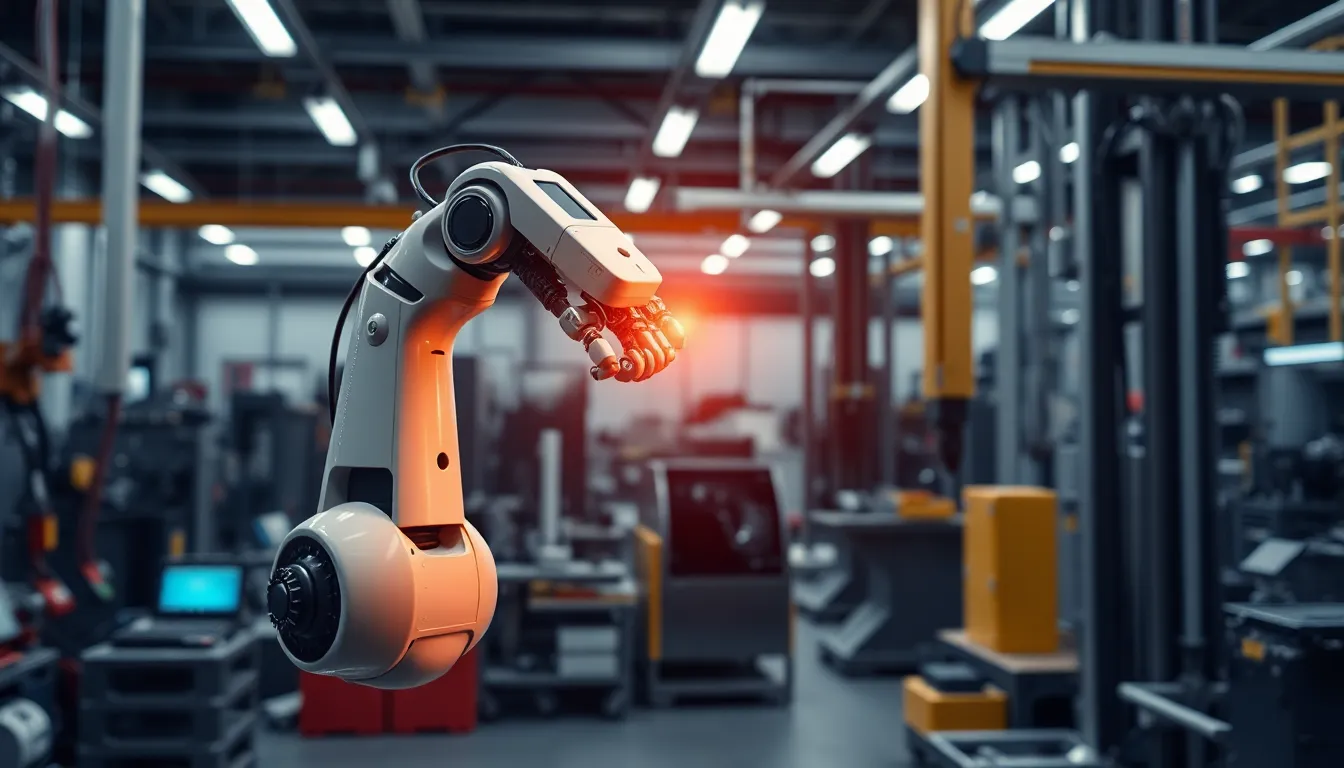The future of robotics isn’t just about shiny metal bodies and whirring gears. It’s a world where robots might soon be more than just your friendly vacuum cleaner. Imagine a life where your personal assistant can cook, clean, and even crack a joke or two—because who doesn’t want a robot with a sense of humor?
Table of Contents
ToggleFuture of Robotics: An Overview
The future of robotics promises significant advancements beyond traditional machines. Robots may evolve into multifunctional personal assistants, capable of handling diverse tasks from cooking to cleaning. New developments in artificial intelligence increase their ability to understand and respond to human emotions, making interactions more relatable.
Industry leaders predict that robots will soon participate in daily human activities, enhancing productivity. In healthcare, robots could assist with surgeries and patient care, improving outcomes and efficiency. Their potential for performing high-precision tasks generates interest among medical professionals.
Education sectors might also benefit, as robots increasingly help engage students. Adaptive learning platforms could utilize robotics to tailor educational experiences to individual needs. Enhancing accessibility becomes a priority, enabling greater inclusivity in classrooms.
A growing focus on collaboration between humans and robots marks another trend. Cooperative robots, or cobots, will work alongside employees across various industries, boosting efficiency and safety. Implementing these systems could lead to optimized workflows in manufacturing and logistics.
Robotics will continue to play a pivotal role in addressing societal challenges. Sustainability initiatives may incorporate robots for environmental monitoring and disaster response. Leveraging technology to create solutions remains critical for future growth.
Overall, robotics is on an evolving path, integrating sophisticated AI and hardware systems that surpass existing limitations. The developments pave the way for a future where robots support everyday life, enhancing both productivity and well-being.
Emerging Technologies in Robotics

Emerging technologies are revolutionizing the field of robotics, allowing for significant enhancements in functionality and efficiency. Innovations like artificial intelligence and advanced sensors are at the forefront, shaping how robots interact with their environments.
Artificial Intelligence Integration
AI integration transforms robotic systems, enabling them to learn and adapt over time. Robots equipped with AI algorithms can analyze their surroundings, process data, and make informed decisions. They exhibit enhanced problem-solving capabilities, making them more reliable in complex scenarios. Tasks previously requiring human intervention now receive assistance from robots that understand emotions and context. Human-robot interaction improves through natural language processing and machine learning, allowing robots to engage in more meaningful conversations. This progression fosters increased trust and collaboration between humans and machines.
Advanced Sensing and Perception
Advanced sensing technology enhances robots’ perception of their environment. Sensors such as cameras, LIDAR, and ultrasonic devices provide vital information about surroundings. Robots can navigate obstacles and recognize objects with precision. Vision systems allow for improved spatial awareness, resulting in safer operation in dynamic environments. Enhanced tactile sensors help robots understand texture and pressure, facilitating delicate tasks. Many industries benefit from these advancements, particularly in healthcare and manufacturing. Collectively, these technologies provide robots with the ability to operate autonomously and interact effectively in human-centric environments.
Robotics in Industry and Automation
Robotics plays a pivotal role in enhancing industry and automation efforts. The integration of advanced robotic technologies significantly boosts efficiency while transforming operational landscapes.
Manufacturing Innovations
Innovations in manufacturing are driving the robotics revolution. Robotics systems optimize production processes, improving speed and accuracy in assembly lines. Collaborative robots, or cobots, are designed to work alongside human workers, enhancing safety while carrying out repetitive tasks. These robots streamline quality control by automating inspection processes and immediately identifying defects. Manufacturing companies that adopt robotics often experience reduced labor costs and increased output. For instance, factories using robots have reported productivity gains of up to 30%, showcasing the tangible benefits of these technologies.
Supply Chain and Logistics
In supply chain and logistics sectors, robotics is reshaping operations for efficiency. Automated guided vehicles (AGVs) transport goods within warehouses, minimizing manual handling and reducing errors. Drones also play a crucial role in inventory management by conducting real-time stock assessments. Companies that implement robotics in logistics often achieve faster delivery times and lower operational costs. For example, firms utilizing robotic solutions can process orders up to 50% faster. Enhanced data analytics in these systems ensures optimized routing and inventory management, improving overall supply chain performance.
Robotics in Daily Life
Robotics is rapidly integrating into daily routines, transforming how individuals live and work. With advancements in technology, robots now enhance home life and improve healthcare.
Home Automation
Home automation systems use robotics to streamline daily activities. Smart appliances simplify tasks such as cleaning and cooking. Devices like robotic vacuum cleaners autonomously navigate homes, maintaining cleanliness effortlessly. Additionally, smart thermostats optimize energy use, contributing to cost savings. Voice-activated assistants control various home devices, allowing for hands-free management of daily chores. Products like automated lighting systems also increase energy efficiency while enhancing comfort.
Healthcare Advancements
Robotics significantly enhances healthcare experiences. Surgical robots enable precision during operations, improving patient outcomes. These systems assist surgeons by providing steady, precise movements that enhance accuracy. Patient care robots assist with tasks like medication management and mobility support. In rehabilitation, robots engage patients in exercises, fostering improved outcomes through personalized therapy. Remote monitoring devices facilitate communication between healthcare providers and patients, ensuring timely interventions. Robotics, therefore, plays a pivotal role in making healthcare more efficient and responsive.
Challenges and Ethical Considerations
Robotics presents multiple challenges and ethical considerations as its integration into society expands. These aspects require careful evaluation to ensure a balanced future.
Job Displacement Concerns
Job displacement remains a pressing issue. Automation in industries may lead to significant workforce reductions, particularly in manufacturing and service sectors. Many fear that robots replacing human roles could exacerbate unemployment rates. According to the World Economic Forum, over 85 million jobs could be displaced by automation by 2025. Workers in repetitive and manual positions are especially at risk, raising concerns about retraining opportunities. Employers and policymakers must collaborate to create re-skilling programs, providing affected workers with new skill sets.
Safety and Security Issues
Safety and security issues also arise as robots become more prevalent. From manufacturing to service industries, the safety of human workers near robots is paramount. Errors in robotic operations could result in physical harm, highlighting the need for strict safety regulations. Moreover, security risks increase with the connectivity of robots, making them targets for cyberattacks. As a result, developing robust cybersecurity measures is essential to protect both personal data and physical assets. Organizations must prioritize the establishment of safety standards to mitigate risks associated with human-robot interactions.
The future of robotics promises to reshape various aspects of daily life and industry. As robots become more integrated into homes and workplaces their ability to enhance productivity and improve personal experiences will be undeniable. With advancements in AI and sensing technologies robots will not only perform tasks but also engage with humans in meaningful ways.
However the journey forward isn’t without challenges. Addressing job displacement and ensuring safety will be crucial in navigating this evolving landscape. By focusing on collaboration between humans and robots society can harness the benefits of automation while mitigating its risks. The next decade will be pivotal in defining how robotics will enhance lives and transform industries for the better.


